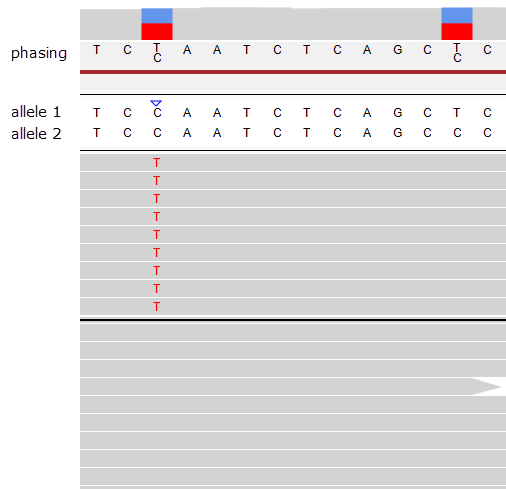Triangles
Triangles mean: there is a difference between the data and the sequence of the selected alleles at this position (“mismatch”).
There are red, purple and blue triangles. All three of them represent mismatches between the data and the reference allele, however, the color is dependent on whether the data and the reference are homozygous or heterozygous at the mismatched position. Each type of triangle is described in more detail below.
Red triangle means:
- The position is homozygous in the data
- The nucleotide at this position in the data cannot be matched with the nucleotide at this position in the reference sequence of the selected allele.

Example: in the data there is a homozygous C at this position, but the reference sequence of allele 2 has a T at this position.
It is concluded that this is a mismatch between the data and the selected allele (allele 2) and this is indicated with a red triangle.
Purple triangle means:
- The position is heterozygous in the data
- The nucleotide at this position in the data cannot be matched with the nucleotide at this position in the reference sequence of the selected allele.

In this example: in the data there is a heterozygous T/G at this position, but in the selected alleles there is a heterozygous C/G at this position.
It is concluded that this is a mismatch between the data and the selected allele (allele 1) and this is indicated with a purple triangle.
Blue triangle means:
- The position is heterozygous in the data
- Only one of the nucleotides at this position in the data could be matched with the reference alleles. Because of phasing to neighboring heterozygous positions it can be determined which one of the 2 alleles contains the mismatch.

In this example: in the data a C can be found at the first heterozygous position.
Allele 1 has a C at this position, however, from the data it was concluded that the C at the first heterozygous position is on the same allele as the C in the neighbouring heterozygous position. The other allele has the T – T motif on these heterozygous positions.
It is concluded that this is a mismatch between the data and reference allele 1. This is indicated with a blue triangle.
The arrows at the bottom left of the analysis screen can be used to jump to the next mismatch (triangle) or question mark.
